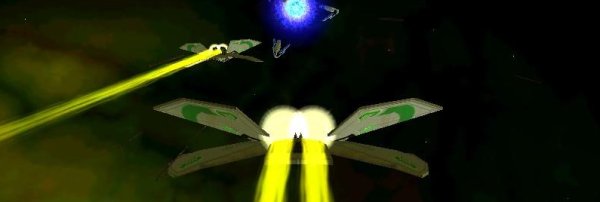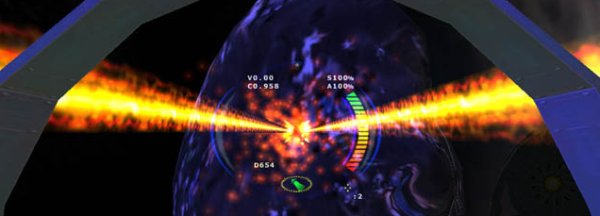Making Of Jumpgate: The Reconstruction Initiative
[With Jumpgate Evolution incoming and Space week entering its final quasar-packed moments, I though it an opportune moment to dig out an Old Making Of I did about the original Jumpgate. I spoke with their Ryan Seabury at an AutoAssault press-event, way back then. The article originally appeared in PCF and has been slightly edited.]
You never know what to expect at a press event. Sometimes it’s simply you being locked in a tiny room with a sinister east-European man for eight hours, demonstrating the unique merits of their ultra-special hexes. In this case, I’ve spent the last five hours running around obstacle courses and similar outdoors pursuits in the company of NetDevil’s Design Director, Ryan Seabury. It's an actual press junket. Sadly, there's little chance to actually point a dictaphone in his direction and talk like gentlemen. Just before we’re whisked in separate directions, I manage to grab five minutes of recorded chat with him. Luckily, Ryan speaks and with enough passion, enthusiasm and speed to fit thirty minutes of normal talk inside this relatively brief frame.
NetDevil are a second-generation MMO team - and in 2005, there's surprisingly few of them around. Few who’ve made one of the non-blockbusting MMOs have gone on to make a second one. Their first game, Jumpgate, was actually the first to really try to “do” the Elite in space thing which Eve: Online eventually made its own. Their new game, Auto Assault, is a sci-fi Mad-Max-style experience which despite its RPG mechanics moves at the pace of an action game. It’s a product of a lot of things they learned from Jumpgate.
“Jumpgate really was Scott Brown’s idea along with Steve Williams, who doesn’t work with us anymore,” says Ryan when asked about the team’s history, “I’d worked with Scott at a different company as an internship way back in the day and he was talking about game ideas and stuff, which got me excited. Eventually, he went to work for himself for a year in a Garage-start-up. He worked on putting the engine together, and Steve helped out with some of the early physics stuff.”
Eventually, their game found publisher interest. “We managed to get an audience with a European telecom company who flew out to Colorado,” Ryan continues, “They liked the game, because it was different. At that point, it was really early in the MMO world, in the mid nineties. Ultima Online was out and proved you could make money with it. Everquest had just launched, and proved it could be massively successful. They picked up the game and funded the rest of the game development. Then there was some shifts in their company structure, and eventually ended up at Mightygames. They had the rights for Europe, so they ran the servers over here”. Which left the issue of a US publisher. “We eventually went with…” Ryan laughs to himself, “3D0 back in the USA with the rest of the rights. But that’s a whole different story.”
In terms of inspiration, Elite is the obvious one. But there was more than that. “Privateer Online had been talked about and never actually happened,” Ryan notes, “And the Wing Commander action games. Other space combat games. We were big fans of that sort of thing. It just seemed obvious for us. Why isn’t anyone else doing this kind of game?”
The biggest initial problem was one of scale. NetDevil weren’t a hundred person mega team. “When I joined, I was the fourth person, and we shipped that game with five people,” Ryan explains, “It was such a small team trying to do such a big game on a relatively tight budget. For a five person team, there was so much to do. There were countless late nights.” Luckily, they had friends watching their back. “We had a really supportive little Beta test community at the time,” Ryan says, “They used to send us pizzas and stuff when we were working late, and be on chat with us. It was really cool. They’d send us messages in pepperoni on the pizzas sometimes.”
That said, it's not they were always completely open, through necessity. It’s a Schrödinger’s situation, in some ways. Devs can only really see how their game works – and get the joy from it – by hiding. “We play on known accounts and secret accounts,” Ryan says, “When you’re on a known account, everyone knows you’re there. When you’re on a secret account, you actually get to see people roleplaying out in space, and doing call-signs back and forth and entire squads forming and just gaming in the universe. They’ve lost touch reality while they’re in the game. You’ve observing them, and they don’t know you’re there. I had an account where I jumped on a station once and saw an entire battle taking place outside the station. Some guys were camping the sector, and another squad comes in… and then people radio out to their friends, and they come in. And there’s a huge battle out in space, and when that was done everyone was talking about it, starting faction and squadron rivalries. There’s just tons of moments like that.”
Generally though, it was hard. “It was a big learning curve for us,” Ryan says, “ It taught us about the sacrifices that you have to make just to get a game shipped. You have an endless features list of things you want to implement, and you just can’t”. When asked to boil it down to the main lessons, Ryan takes three key insights. “The first was accessibility. We had a very feature rich game, but we had a big challenge in actually getting people to understand what it could do," he says, "It was so overwhelming and the learning curve was so high, you couldn’t get into it. A casual gamer certainly wouldn’t. Only the most hardcore player could actually go through the pains.”
“The second thing was content,” he says, “Jumpgate was a relatively content light game. It had some mission generation systems, but really depended on the player to make their own stories. Which was great, in the sense there was a lot of role-playing going on and a lot of back and forth between the factions. But not a lot of content in the actual universe to get into, so you had to make up your own story.”
“The third thing,” he says, “was having an identity in the world. In Jumpgate, you were the space-ship. You could only have one space-ship active at a time, and you had to trade out all your stuff. It was just really clumsy. You had no identity.” This has changed in Auto Assault, where you have a character avatar you can dress up and control as you walk around the in game cities.
Their biggest achievement was actually completing their Sisyphean task. “I just think it’s a testament to how much hard work went into it with such a small team, and we actually managed to ship a game,” Ryan says, “There was a lot of our competition at that time which never actually hit the shelves. To look back at it and realise that we got it out to retail, and into the hand of at least some people is really amazing to me. I don’t think people realise how big MMOs are in terms of the feature set you have to do complicated with the networking, which you have to do at a bare minimum to keep people happy.”
The pay-off for Ryan was seeing everything play out before him, once the game was out in the world. In fact, the game was its own world “It was a living universe,” he says, “It was cool to get in there and see people taking ideas you brainstormed with your buddies… and then building on them. Some people are making their own stories, which we’re seeing in Auto Assault. It’s just cool, that your crazy ideas are things people are into it… because it was a cool idea. Seeing people get the enjoyment, because ultimately we’re entertainers. When people are entertained, and very clearly entertained, it’s just… well, I don’t want to get mushy and bleeding heart, but it’s a really cool feeling.”
Anything else you’re proud of, Ryan? “Well, the best galaxy map ever written in code,” he grins, “Because I wrote it. Just kidding there.”
He pauses, “No, it really is the best”.




